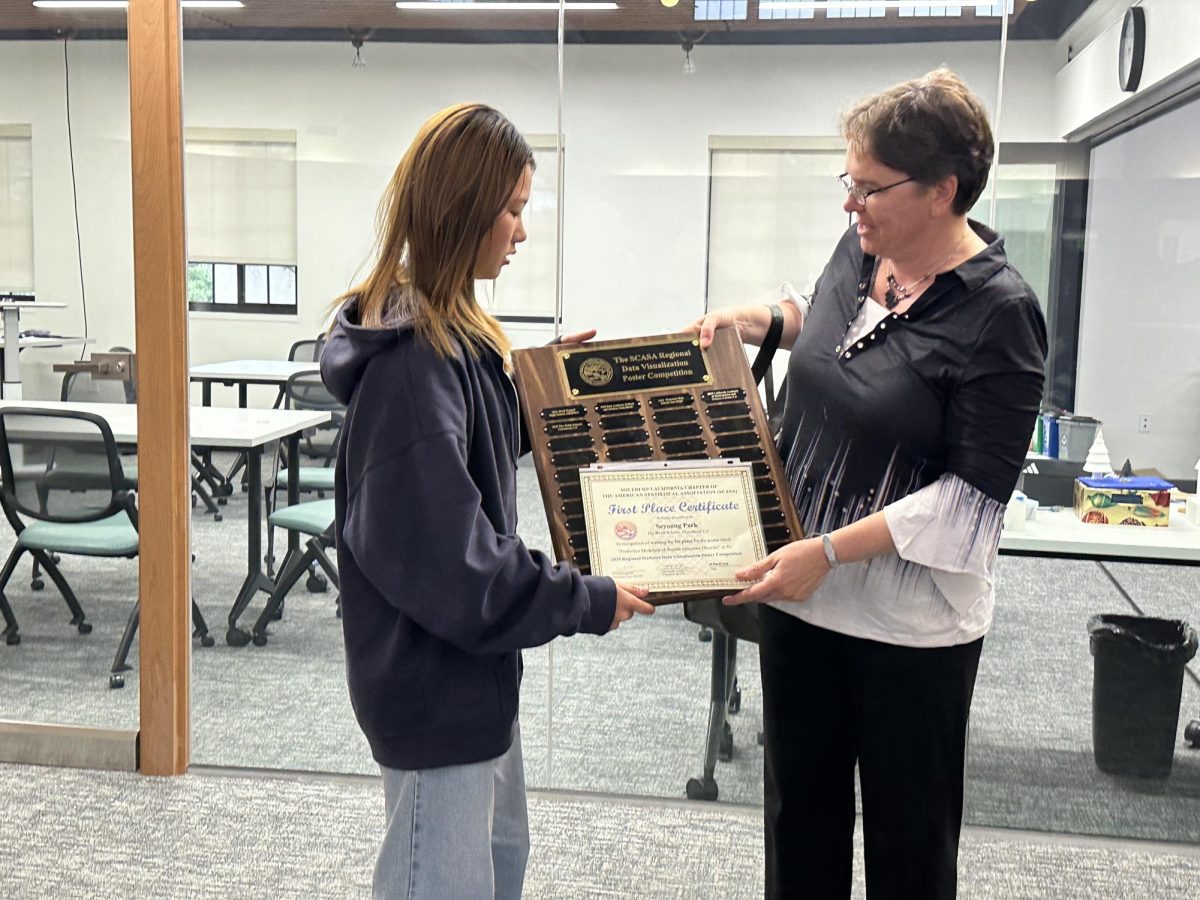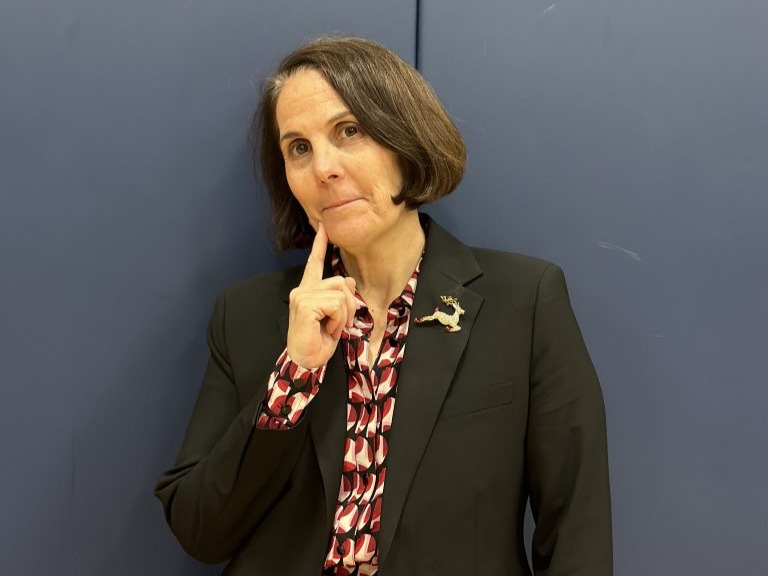Beads of sweat splatter the asphalt road leading up to the gym as students huff and puff up the infamous Gym Hill. Suddenly, the hum of an electric motor grows louder, as Lucas Li (‘24) whizzes past aboard his Onewheel GT, disappearing out of sight as swiftly as he arrived. For the students and faculty who own personal motorized transportation, the hilly campus has never been so effortless and exhilarating to navigate.
“I love riding the Onewheel on the trail behind Chandler, the one with the aqueduct next to it,” said Lucas, a rider with over 800 miles under his belt. “I sometimes use it out on the field to help with drone retrieval when we accidentally crash them.”
True to its name, the Onewheel Company produces eye-catching if not bizarre vehicles that balance on a singular pneumatic Go-Kart tire, propelling the rider up to 23 miles per hour with its three-horsepower, 750W HyperCore electric hub motor. In order to help the rider stay (mostly) balanced atop, an inbuilt gyroscope like those found on Segways and Hoverboards, controls the motor’s direction and power depending on where the rider leans.
Unlike most of its counterparts, however, the Onewheel’s large tire and unique ride style mean it readily takes on off-road conditions. Boasting a remarkable 20-mile range, the Onewheel easily covers Lucas’s daily commute up and down Webb’s campus for an entire week without additional charging.
However, it may be important to note that the Onewheel remains a potential risk to its riders, especially due to the many bumps and dips found on Webb’s roads. With 10 crashes to date, Lucas has experienced a lot of injuries — including scrapes and burns — as a result of unplanned rapid body-assisted deceleration movements.
It is also rather expensive, with the base model Onewheel GT costing a hefty $2,200. Even the cheapest Onewheel model, the Pint, comes with a price tag of $1,050 (Note, these prices do not take into account prices of bandages and hospitalization).
At the end of the day, Lucas still firmly advocates for the Onewheel, recommending it to the Webb community as a fun, portable, stylish, and effortless way to travel.
Another student who has been navigating the campus via electric vehicle is Terrence Wu (‘23). His vehicle of choice is a more traditional electric skateboard, appearing as a simple longboard but with a battery and electric motor strapped to its underside. The specific model, the Backfire G2, is advertised for its beginner friendliness and affordability, costing only $399.
“The Backfire G2 really caught my attention because of how cheap it was compared to a lot of the other electric skateboards, while still having a lot of speed, range, and power,” Terrence said. “As someone who had never even skateboarded before, that was all I really cared about.”
Instead of controlling the board by leaning, the Backfire G2 comes with a handheld remote controller, allowing the rider to control the speed of the board with ease. Powered by two 400W Hobbywing Hub motors placed inside the rear wheels, the board accelerates effortlessly up to 25 miles per hour, with or without the rider still on top.
This also means that it has no trouble powering up the steep roadways like Gym Hill at surprising speeds. However, with small rubber skateboard wheels, rear-wheel drive, and the lack of any form of suspension, the G2 is ill-suited for any terrain outside of smooth asphalt and pavement, as Terrence had discovered with his own share of crashes after the board encountered unexpected rocks, sand, or bumps.
“While it’s definitely not the safest way to get around campus, the fun and thrill is certainly worth it,” said Terrence, gesturing to one of his many scars that resulted from riding his board. “But to be fair, these could probably all be avoided if it was a more prudent rider.”
Even for faculty members, electric transportation is an attractive means of getting around our terraneous campus. For Sonsoles Cardalliaguet, World Languages Department Faculty, electric transport brings all the benefits with little-to-no cons.
After 14 years of teaching, Ms. Cardalliaguet decided it was time for a change after walking up one too many Gym Hill treks in her career. Looking for no specific requirements except efficient speed, she introduced the Super Turbo 1000-Elite electric scooter into her life, allowing her to surpass Webbies on the same path up the hill with unprecedented ease.
Living right next to campus, Ms. Cardalliaguet uses her scooter to make the daily commute to school that is cumbersome with a car, yet tedious to make on foot.
“I didn’t want to use my car on campus,” said Ms. Cardalliaguet. “I live right next to the entrance [of Webb] and since there’s not a pedestrian crossing, it can be dangerous to walk.”
The speed, an important factor for late mornings and midday runs, ranges from 18-27 miles per hour on the scooter. Clocking in at a 100 pounds of high-tensile steel, the scooter allows Ms. Cardalliaguet to glide across campus on a vehicle propelled by a 1000watt 36v motor that spins at 3000rpms along with a Deep Cell 36v 12ah lead acid battery pack that claims to last at 350 charge cycles. The scooter is also priced averagely, running for about $699 on the maker’s website.
Like all electric transport vehicles, one can save on added costs — both for your pocket and the environment. With gas maintaining a steady average of six dollars per gallon in California and the adverse effects of fossil fuels plaguing our planet, the fully electric component of the scooter helps reduce unnecessary costs and emissions.
Averaging about six to eight hours for a full charge, the scooter can travel about 10-18 miles per hour under ideal conditions, faltering slightly in changes of terrain. However, after about half a decade of use, the performance capabilities of the scooter are long past its prime.
“The battery is not as good as it used to be,” Ms. Cardalliaguet said. “So, it’s not as fast now.”
Regardless, the scooter takes her to places in half the time it takes to walk, conserving energy and effort with an easily manageable mode of transport she is already familiar with.
“Back in my hometown in Madrid, Spain, a lot of people use scooters,” Ms. Cardalliaguet said. “I also really liked the idea of just riding around with this climate and nice weather.”
Both for leisurely rides and efficient transportation, the scooter serves as a viable means of getting around campus with adequate speed and long-lasting capabilities. As such, it is another attractive option for those who want to invest a bit more money in return for an upgraded ride.
As just three out of dozens, if not hundreds of alternative methods to traverse Webb’s campus, everyone can easily find more options varying in power, price, and style depending on what suits one’s own needs. However, it is important to keep in mind the caution for the safety of both yourself and others. But for those willing to pay the price and take the time to master their wheels, an exhilarating new world awaits.
*Author’s Note: Co-author Terrence Wu is also the Editor of Technology and is interviewed in this article. As a prominent stakeholder for our focus and someone who holds a lot of experience with using electric vehicles on campus, we felt it was appropriate to interview him and use him as a source in this article. We have also made sure that his views and biases were reflected in his section and quotes alone and treated him equally as any other interviewee in this article.





![All members of the Webb Robotics Winter season teams taking a group photo. Of note is Team 359, pictured in the middle row. “It was super exciting to get the win and have the chance to go to regionals [robotics competition]” Max Lan (‘25) said. From left to right: Max Lan (‘25), Jerry Hu (‘26), David Lui (‘25), Jake Hui (’25), Boyang Li (‘25), bottom Jonathan Li (’25), Tyler Liu (‘25)](https://webbcanyonchronicle.com/wp-content/uploads/2025/03/Screenshot-2025-03-10-at-2.41.38 PM.png)




